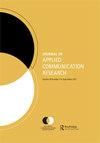Exploring Multiracial identity, demographics, and the first period identity crisis: the role of the 2020 United States Census in promoting monocentric norms
IF 1.7
2区 文学
Q2 COMMUNICATION
引用次数: 2
Abstract
ABSTRACT Guided by Multiracial critical theory and actor-network theory, this study examines how the United States Census options for ethnicity and race reinforced monocentric norms (the assumption that everyone should fit into a distinct racial-ethnic category) and White Supremacy for Multiracial individuals. Five hundred and thirty-nine Multiracial young adults answered open-ended questions about the 2020 United States Census, including why they chose specific ethnic-racial categories and how they felt about the choices provided. Overall, we found that the U.S. Census stabilized monocentric norms and White Supremacy by (1) stabilizing monoracial assumptions, (2) stabilizing the exclusion of racialized groups, and (3) stabilizing Asian American stereotypes. However, Multiracial participants could challenge and destabilize these norms by filling out the Census strategically. Finally, we discuss policy implications and how social scientists, researchers, and data collection agencies can measure race and ethnicity more compassionately and comprehensively to reduce Multiracial stigma.探索多种族身份、人口统计和第一时期身份危机:2020年美国人口普查在促进单中心规范方面的作用
在多种族批判理论和行动者网络理论的指导下,本研究探讨了美国人口普查中关于民族和种族的选项如何强化单中心规范(假设每个人都应该属于一个独特的种族-民族类别)和多种族个体的白人至上主义。539名多种族年轻人回答了有关2020年美国人口普查的开放式问题,包括他们为什么选择特定的种族类别以及他们对所提供的选择的感受。总体而言,我们发现美国人口普查通过(1)稳定单一种族假设,(2)稳定种族化群体的排除,以及(3)稳定亚裔美国人的刻板印象来稳定单中心规范和白人至上。然而,多种族参与者可以通过战略性地填写人口普查来挑战和破坏这些规范。最后,我们讨论了政策影响,以及社会科学家、研究人员和数据收集机构如何更有同情心和全面地衡量种族和民族,以减少多种族耻辱。
本文章由计算机程序翻译,如有差异,请以英文原文为准。
求助全文
约1分钟内获得全文
求助全文
来源期刊

Journal of Applied Communication Research
COMMUNICATION-
CiteScore
4.00
自引率
8.70%
发文量
52
期刊介绍:
The Journal of Applied Communication Research publishes original scholarship that addresses or challenges the relation between theory and practice in understanding communication in applied contexts. All theoretical and methodological approaches are welcome, as are all contextual areas. Original research studies should apply existing theory and research to practical solutions, problems, and practices should illuminate how embodied activities inform and reform existing theory or should contribute to theory development. Research articles should offer critical summaries of theory or research and demonstrate ways in which the critique can be used to explain, improve or understand communication practices or process in a specific context.
 求助内容:
求助内容: 应助结果提醒方式:
应助结果提醒方式:


